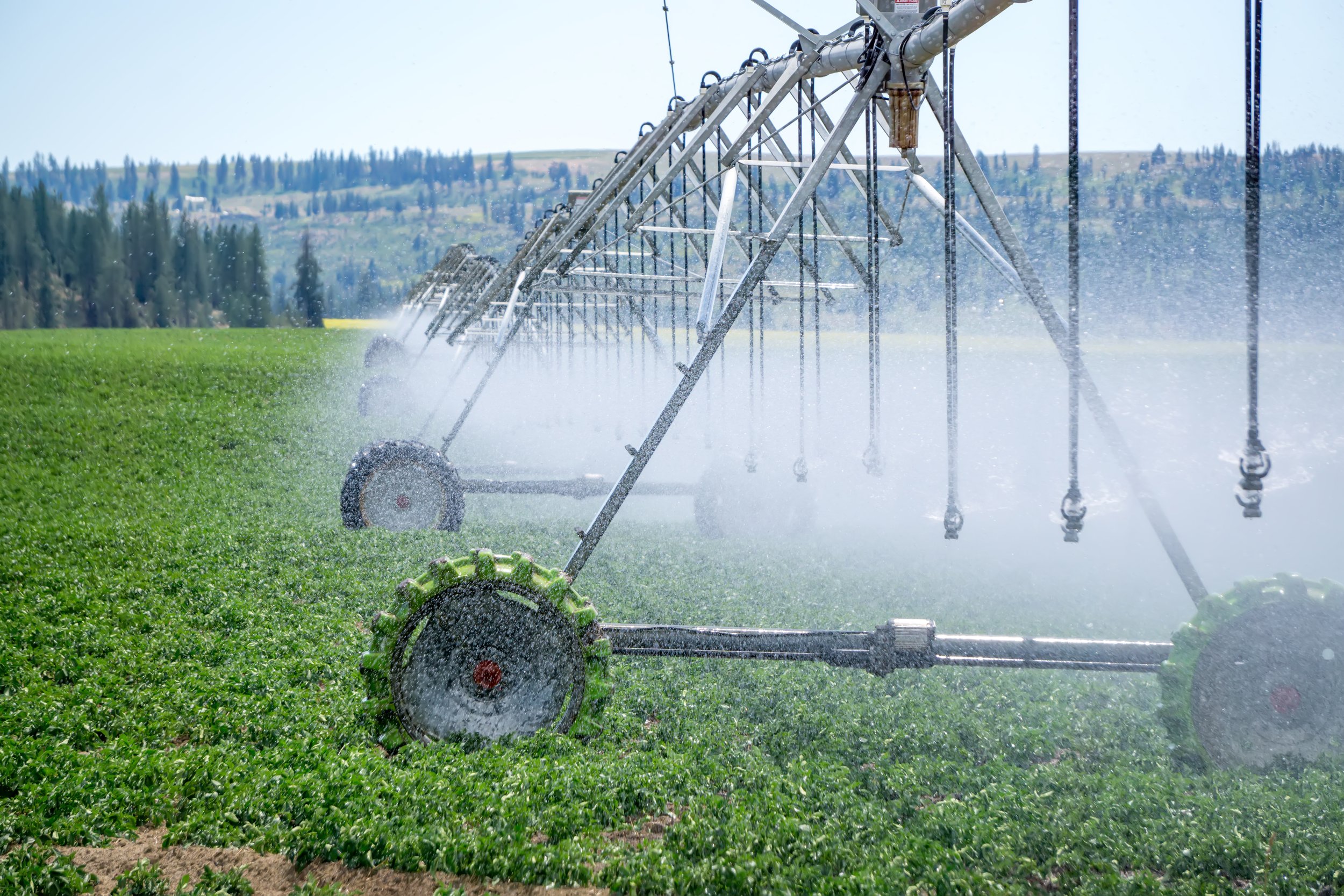Status of 2024 Idaho Water Curtailment
by Sidnee Hill
For most Idaho groundwater users in the Eastern Snake Plain Aquifer (ESPA) the Curtailment Order[1] issued by the IDWR on May 30th,2024 was seen as a death blow that came out of nowhere. Overnight, producers of collectively 500,000[2] acres found themselves potentially at risk of being without water for crops they had just planted in the ground weeks before. If the order remains as it stands, without an emergency stay from the state’s governor, they will be forced to stand by and watch their crops, and livelihoods, wither under the Idaho sun.
This whole situation is undeniably heartbreaking, but students of Idaho water law and history wouldn’t call it a surprise, but another painful bump in what has been a decades long road filled with litigation battles and curtailment calls.
To understand how we have fallen into this situation, and what it means for Idaho farmers and landowners moving forward, we must first understand the basics of Idaho water laws. Idaho water law, much like most of the west, is allocated under the Prior Appropriations Doctrine, also known as “first in time, first in right”, which states that those individuals to first prove and file use of Idaho’s water “in a beneficial way” receive priority right to that water over those who would come later. Today those with the oldest filed water rights (senior water users) still receive priority water delivery over younger and newer water rights (junior water users). In times of drought or water shortage junior water users must stop, or curtail, their use of water so that older, more senior rights may enjoy full use of their priority rights and water. This law applies to both ground and surface water users conjunctively.
When Idaho irrigators offhandedly mention that people have been murdered over the difference between who holds the more senior water right: it is no joke at all. In light of our recent widespread curtailment of ground water use, it is easy to see how getting irrigation water in the early 1900’s would truly be a matter of life or death. So in the late 1950’s when senior surface water users in the Twin Falls canal company saw their streams dry up, they went for blood. Luckily, by this time justice was sought through the court system. After decades of litigation, and countless studies into Idaho’s water systems, it was determined that junior ground water use through the Eastern Snake Plains were to blame for the loss of water. From this litigation the Methodology Order was born and upheld by the Idaho Supreme Court to provide two primary functions; 1. Provide proof of injury of senior water rights through ground water use, and, 2. Provide rules for mitigation when such an injury happens.
From here it is helpful to move to a simplified timeline to better understand how such a devastating story of curtailment unfolds:
- October 1900- Twin Falls Canal Company files their surface water rights.
- 1950- Eastern Snake Plain Aquifer (ESPA) reaches highest fill level recorded, but then proceeds to steadily decline due to increasing population and less recharge from irrigation as flood irrigation practices transitioned to sprinklers. Despite this, Idaho continues to approve ground water well permits and associated junior water rights. Litigation begins between senior surface water users in the Magic Valley and ESPA groundwater users.
- 1994- A&B Irrigation District calls for their water- would have required first curtailment of groundwater uses. Agreement is made to circumspect that outcome and no curtailment needed.
- 1995- Ground water districts are formed in the ESPA to help groundwater users better comply with increasing water regulations & requirements. [3]
- 2015- IDWR calls on Junior ground water users in the ESPA to curtail water use to satisfy senior water right amounts.
o Junior ground water users agree to collectively reduce their pumping by 240,000 acre feet a year.
o State initiates aquifer recharge program of an average of 250,000 acre feet a year.
- 2016- A settlement is reached between the Surface Water Coalition and ESPA groundwater districts to form the Idaho Ground Water Appropriators, a coalition that combines all groundwater districts’ efforts for mitigation together. [4]
- Spring 2023- Eastern Snake Plain Aquifer reaches all-time low level since first accurate measurements began in 1950.
- March 20, 2024- Senate Bill 1341 extends the boundary of ESPA. These new areas are subject to curtailment as well. However, IDAPA 37.03.11 allows IDWR to determine whether phased-in curtailment, extending no greater than 5 years, is appropriate.
- April 2024- Senior surface water users in the members of the Surface Water Coalition face a shortfall of 74,100 acre-feet of water for the 2024 irrigation season. IDWR’s Methodology Order determines that the shortfall is the result of Junior groundwater pumping from the Easter Snake Plain Aquifer (ESPA).
- April 18, 2024 IDWR issues notice to ESPA groundwater districts of need to supply mitigation notices to demonstrate their compliance with approved mitigation plans. [5]
- May 2, 2024- Groundwater District Notices Due.[6]
- May 10, 2024- IDWR Director Mathew Weaver finds that the mitigation notices filed by the ESPA ground water districts to be deficient and fail to meet the requirements of the approved mitigation plans. Two ground water districts failed to file any mitigation plan. IDWR extends due date to the 17th. [7]
- May 10-17- Six ground water districts, of the 11 in the ESPA, refuse or fail to comply with either of the two approved mitigation plans set by IDWR’s Methodology Order.
- May 30, 2024- the following six groundwater management districts are found to be incompliant with the ESPA approved mitigation plans. Order is released for the curtailment of water affecting 500,000 irrigated acres (6,400 groundwater rights) in the following districts: Bingham Ground Water District, Bonneville-Jefferson Ground WD, Jefferson-Clark WD, Magic Valley WD, Carey Valley WD, and North Snake WD.
o Water rights junior to March 31, 1954 are subject to curtailment.
o Watermasters are ordered to begin curtailment
- June 4, 2024- IDWR celebrate sending 379,000 acre feet of water to ESPA recharge efforts.
- July 2024- IDWR Director Mathew Weaver will issue an updated order determining any further shortfall in water supply to the senior surface water right holders.
Water calls and curtailment issues are obviously not new in this ongoing water war. What then makes this year different? Contention and confusion. Groundwater districts unable or unwilling to work with each other were forced to submit their own mitigation plans separate from the previous coalition Idaho Ground Water Appropriators established in a 2016 settlement. Many of the districts tried going straight to the senior surface water holders to work out an agreement separately, stating that their impact to the surface water shortfall is significantly lower than other districts and should be mitigated as such. Each proposal was denied. As stated in the IDWR’s May 30th news release, “Because of ongoing disagreement with the Department and amongst themselves, the groundwater districts facing curtailment ultimately chose not to comply with either of their plans in the manner required. As a result, many junior groundwater users will be curtailed who might otherwise have been spared.”
Confusion also abounded as many districts were frustrated with the mitigation plans set forth by the state. Many felt that the state department was “moving the goal post” for compliance. The first plan requires that groundwater districts increase their annual reduction obligation of 240,000 acre-ft by an additional12,000 acre-ft per year until a predetermined benchmark is met. The second mitigation plan requires the districts to provide the entire shortfall in rented storage water to the senior Surface Water Coalition. Although IDWR maintained that to be found in compliance all districts must implement the full plan and that individual “mixing and matching of plans” is not allowed, many districts proposed their own such solutions to the state. In many ways these individual solutions exceeded what was being asked of them. In a letter to members the North Snake Ground Water declared, “we put our best and fairest foot forward-and then some- but it remains to be seen if the director agrees.” The director did not accept their proposal and the district has been determined in non-compliance.
What is to be done in the wake of what we now clearly see as an ongoing struggle for water balance? First all eyes remain on Governor Brad Little. He alone holds the power to issue an emergency stay of the order. However, as we have seen, such a decision is not clear cut and would come with heavy consequences. Any decision would pit him against large groups of farmer constituents, his own government departments, and Idaho’s water laws protected within its constitution. No one can blame him for treading lightly on such a minefield decision.
The latest news is that Minidoka and North Snake districts have agreed to an IDWR approved mitigation plan. The other 4 districts out of compliance have proposed to revert to the 2015-16 agreement that would allow them to purchase water to mitigate the damage. Whether or not the state and Surface Water Coalition will agree with this is still up in the air. If a decision cannot be reached before June 15th affected groundwater farmers will be forced to dry up the required ground and pray fervently for rain. I, for one, will be praying for them as well.
[1] Water curtailment means that the farmer will have to restrict or stop completely their use of irrigation water.
[2] Put into perspective 500,000 acres is greater than the entire Franklin County in Idaho (426,880 sq acres) or 15% of Idaho’s irrigated lands.
[3] 199711-Groundwater-District-Handbook.pdf (idaho.gov)
[4] Summary of ESPA Settlement Agreement|Racine Olson (racinelaw.net)
[5] CM-DC-2010-001-20240418-Final-Order-Regarding-April-2024-Forecast-Supply-Methodology-Steps-1-3.pdf (idaho.gov)
[6] CM-DC-2010-001-20240502-Joint-Notice-of-Compliance-MVGWD-NSGWDs-2024-Irrigation-Season-Mitigation-Commitments-.pdf (idaho.gov)
[7] CM-DC-2010-001-20240510-Order-Determining-Deficiency-in-Notices-of-Secured-Water.pdf (idaho.gov)


